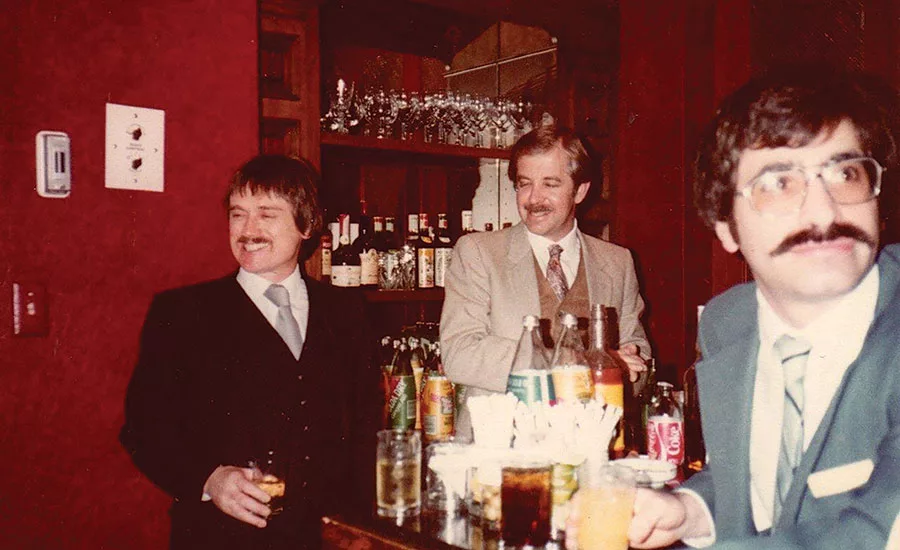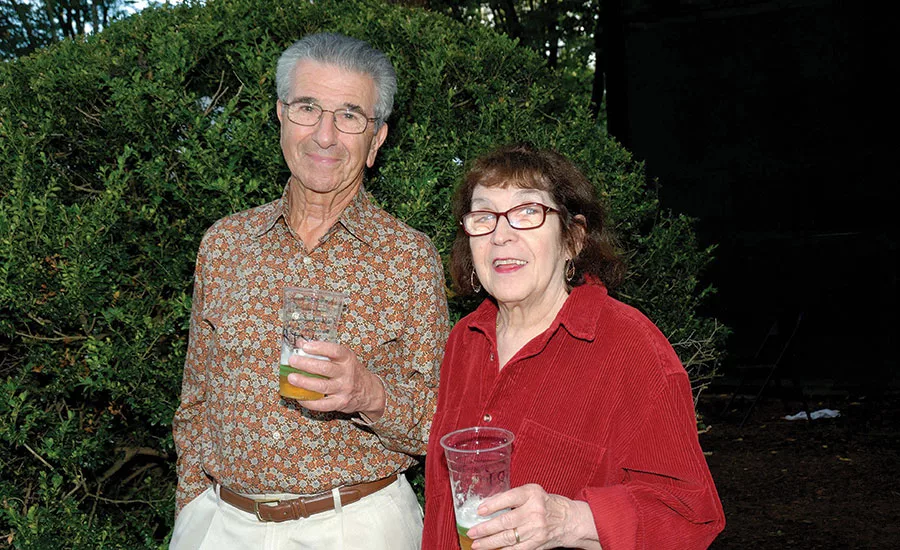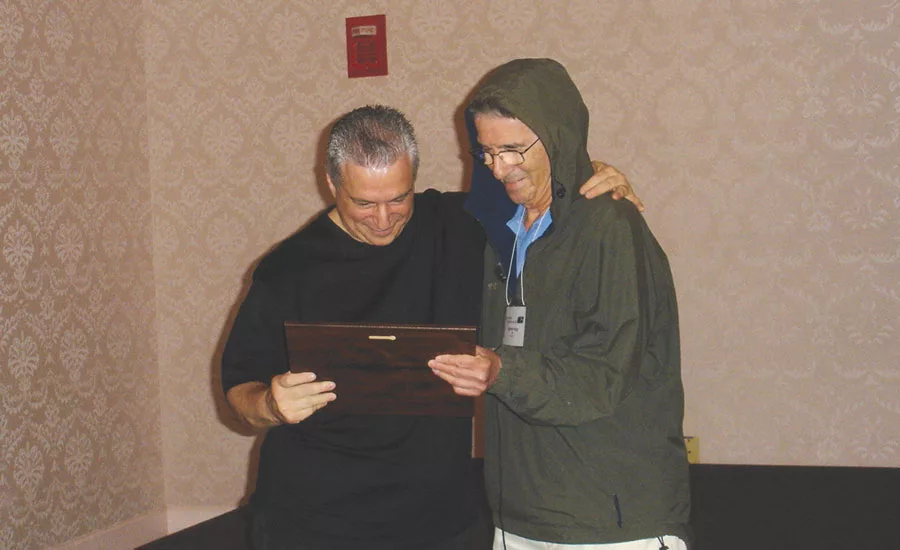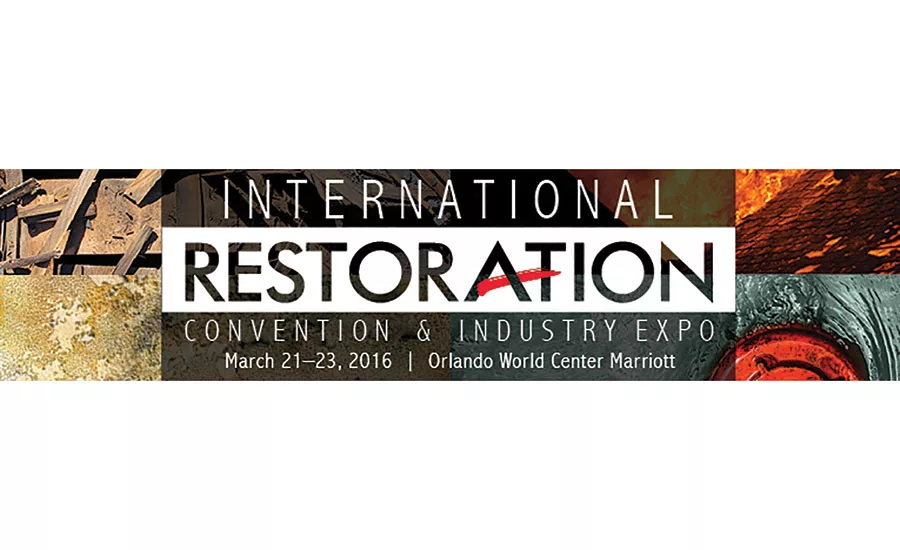A Brief Walk Through RIA History
Celebrating RIA's 70 Years of Industry Leadership

Restoration Good Fellas: These men were affectionately coined the “Restoration Good Fellas.” From left to right: Ron “Alfie” Alford; Major Long, CR; and Clifford “Cliff” Zlotnik, CR, WLS, CMH. Alford gained fame in the industry in the 70’s and 80’s doing high-profile projects for celebrity clients and his interviews on broadcast TV morning shows. Long was the ASCR President in 1980 and was a well-respected technical mind in the industry serving as an ASCR technical adviser from 1985-88. Zlotnik, was ASCR President in 2001 and an honorary member of RIA as is Consigli and the deceased King. Zlotnik aka the Z-man is co-host of the popular IAQ Radio podcasts.

Marty King and his wife, Judy, pause for a photo during the Joe Lstiburek’s Summer Camp in August of 2008. Marty, a true pioneer and founding father of the restoration industry, passed away on May 7, 2015.

In a rare moment, Pete Consigli was left speechless while being presented with the MLK Award during the 2009 Westford Building Science Symposium, AKA Summer Camp. It was the last time Marty presented the award before his passing.

This month, the Restoration Industry Association celebrates 70 years of leadership in an ever-growing, ever-evolving, and ever-changing industry. Like the restoration world, the association has changed names, leaders, and focuses a number of times over the years. But at its core, the RIA is the same today as it was when it was founded in 1946: an organization focused on serving other people.
The association was founded in 1946 by 10 large rug cleaning companies, as the National Institute of Rug Cleaning (NIRC). Over the last 70 years, there have been three rebrands. In the 1960’s, the NIRC became AIDS (the Association of Interior Decor Specialists). In 1981, AIDS was rebranded for obvious reasons to the ASCR, the Association of Specialists in Cleaning Restoration. However, it was under the earlier AIDS moniker that sectors of the restoration and remediation industry really began to emerge.
“Under the AIDS banner, the association moved to operating divisions, but they all meshed,” explained RIA Education Director and Industry Adviser Pete Consigli, CR, WLS.
The seven divisions were rug cleaning, drapery, carpet and upholstery cleaning, fire restoration, installation, cleaning and janitorial, and a home decorating division.
“But over time, the divisions fell,” Consigli said. “The divisions that fell were the decorating division, the janitorial division, the installation division, then the drapery division, in that order.” Divisions most closely tied to restoration, like fire restoration, survived.
In 1971, the late Marty King, founder of the Certified Restorer program, started the National Institute of Fire Restoration (NIFR), which accounted for the fire restoration operating division under the AIDS banner. Consigli likens a Certified Restorer certificate to having a Ph.D. in restoration. In the late 90’s, the NIFR changed its name to the National Institute of Disaster Restoration (NIDR).
As the newly-named NIDR grew, so did ASCR as an association under which the NIDR banner flew (remember, AIDS was re-branded to ASCR in 1981). A water loss specialist division was added to the ASCR brand at the 50th annual convention in 1995. That was known as the Water Loss Institute (WLI).
Under the NIDR brand, ASCR published the NIDR Guidelines for Smoke and Fire Damage Restoration in 1997 which later was followed up with an anglicized version for the UK market. Over the past 2 decades these guidelines has been the industry accepted best practices document. RIA since 2010 started the development and publication of ANSI accredited Fire Restoration Standards in partnership with IESO now under the management of ASHRAE.
In February of 2007, the ASCR announced the decision to rebrand into today’s Restoration Industry Association.
The Evolution of Advanced Certifications
Toward the end of the 20th century, advanced certification programs that are still so popular today were developed. The Certified Restorer program was started in 1980.
“The Certified Restorer certification is the best example of how RIA has established itself as the thought-leader and primary association for the restoration professional,” said RIA Executive Director Marc Selvitelli during a recent conversation with R&R. “In order to obtain the certification, a restorer must demonstrate a comprehensive body of knowledge through training and experience. This body of knowledge and experience not only gets into the scientific depths and theory of all facets of restoration, it also examines the complex nature of a successful restoration business.”
After the CR program came some of the other major industry certifications.
“In a five year period, from about 1995 to 2000, we developed several other advanced certifications,” Consigli said. “The mainstay now is the WLS program, the Water Loss Specialist.”
The other certification programs, more unrelated to the restoration industry specifically, were the Certified Rug Specialist (CRS), Certified Mechanical Hygienist (CMH), and Certified Fabric Specialist (CFS). It’s interesting to note that it was the founder of CMH who helped establish today’s standards for duct cleaning, which is certainly emerging more and more as an add-on restoration service.
The Certified Mold Professional (CMP) certification came along a little later.
Today’s RIA
Over the years, RIA has worked hard to set itself apart from other restoration associations and organizations. There have truly been dozens of local, regional and national organizations, but this one has remained and is solely dedicated to the restoration sector on a global scale.
Today, RIA still offers CR, WLS and CMP certifications.
This year, RIA plans to publish the long-anticipated Certified Restorer Curriculum, which the association calls “the complete body of knowledge for those pursuing excellence in restoration education and training”. This consensus-based document has been in development and undergone an extensive industry-wide peer review over the last six years. After publication, RIA’s advanced certifications and educational programs will be updated in 2017 to align with the core competencies of the body of knowledge.
RIA has more members than ever in Canada and Australia after several major initiatives in 2015, including a partnership with the Restoration Contractors Organization of Canada (RCOC).
The RIA says its Canadian members “benefit from this increased network, as well as from RCOC’s lobbying and legislative monitoring efforts within the Canadian provinces.” Plus, there is a Canadian Council of the RIA and a Canadian Young Professional Restorers’ Committee, which is actively working to engage the next generation of restoration leaders.
Similarly, Australians have had a growing role in the RIA. In 2014, an Australian, Ashley Easterby, earned the prestigious Martin L. King Award for contributions to the international restoration community. The RIA Building Science course, a prerequisite for the CR and WLS certification prep courses was also offered last fall in Australia, and there was an RIA Day at an Australian convention called AUSCLEAN.
Selvitelli says new or prospective members sometimes don’t even realize just how many benefits they get by being an active member.
“When most people join an association, they cite education and networking as the two prime reasons,” he said. “RIA provides numerous educational opportunities and forums for members to network and share ideas with their peers. But participating in an RIA event or within the RIA governance also allows restorers to share their knowledge and gain knowledge from other restorers who aren’t local competitors. This is a critical association benefit as you are unlikely to have this level of conversation with restoration firms in your local market.”
The Future of RIA
The future is looking bright for RIA as they plan to grow, and foster the next generation.
“In the next decade, I believe you will see an increased focus on reinforcing RIA’s position as the leading authority and resource for advancing the art, science, and management of the restoration profession,” Selvitelli explained.
Selvitelli explained three ways they plan to move forward:
1. Develop new standards.
2. Offer more small, niche conferences on specific industry conferences, similar to the Forensics Restoration Conference launched with massive success last fall.
3. Establish technical guidelines for certain elements in the industry.
And to the next generation rising in the restoration ranks, be on the lookout for a larger RIA focus on resources for you to help you prepare to run or own your own company down the road.
Help Celebrate!
This year’s RIA International Restoration Convention & Industry Expo will include a special 70th anniversary celebration and awards banquet on Tuesday evening, March 22.
Congrats to RIA for reaching such a momentous milestone!
Looking for a reprint of this article?
From high-res PDFs to custom plaques, order your copy today!







